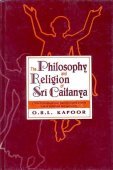Vrindavana, Vrimdavana, Vrinda-vana, Vrindāvana, Vṛndāvana: 16 definitions
Introduction:
Vrindavana means something in Hinduism, Sanskrit, the history of ancient India, Marathi. If you want to know the exact meaning, history, etymology or English translation of this term then check out the descriptions on this page. Add your comment or reference to a book if you want to contribute to this summary article.
The Sanskrit term Vṛndāvana can be transliterated into English as Vrndavana or Vrindavana, using the IAST transliteration scheme (?).
In Hinduism
Vaishnavism (Vaishava dharma)
Source: ISKCON Press: Glossary1) Vṛndāvana (वृन्दावन).—Kṛṣṇa’s eternal abode, where He fully manifests His quality of sweetness.
2) Vṛndāvana (वृन्दावन).—The village on this earth in which He enacted His childhood pastimes five thousand years ago.
3) Vṛndāvana (वृन्दावन).—The topmost transcendental abode of the Supreme Lord. It is His personal spiritual abode descended to the earthly plane. It is situated on the Western bank of the river Yamunā.
Source: Pure Bhakti: Brhad BhagavatamrtamVṛndāvana (वृन्दावन) refers to:—The forest of Vṛndā; the famous place where Śrī Kṛṣṇa enacted His enchanting līlās, such as rāsa-līlā. Vṛndāvana is situated approximately 12 kilometers northeast of Mathurā, along the western bank of the Yamunā River. It is one of the twelve forests of Vraja. (cf. Glossary page from Śrī Bṛhad-bhāgavatāmṛta).

Vaishnava (वैष्णव, vaiṣṇava) or vaishnavism (vaiṣṇavism) represents a tradition of Hinduism worshipping Vishnu as the supreme Lord. Similar to the Shaktism and Shaivism traditions, Vaishnavism also developed as an individual movement, famous for its exposition of the dashavatara (‘ten avatars of Vishnu’).
Purana and Itihasa (epic history)
Source: Cologne Digital Sanskrit Dictionaries: The Purana Index1) Vṛndāvana (वृन्दावन).—Sacred to Rādhā.*
- * Brahmāṇḍa-purāṇa III. 33. 24; 36. 32. Matsya-purāṇa 13. 38; Viṣṇu-purāṇa V. 25. 4.
2) Vrindāvana (व्रिन्दावन).—The Gopas immigrated to this forest region from Vraja to avoid omens that threatened that place.*
- * Viṣṇu-purāṇa V. 6. 24 ff; 16. 1.

The Purana (पुराण, purāṇas) refers to Sanskrit literature preserving ancient India’s vast cultural history, including historical legends, religious ceremonies, various arts and sciences. The eighteen mahapuranas total over 400,000 shlokas (metrical couplets) and date to at least several centuries BCE.
General definition (in Hinduism)
Source: Wisdom Library: HinduismVṛndāvana (वृन्दावन)—One of the seven forests on the western bank of the Yamunā.
Source: Google Books: The Sword and the FluteFinally, in perhaps his most famous “battle” in Vṛndāvana, Kṛṣṇa defeats the many-headed serpent Kaliya. Kaliya lives in a nearby stream and has poisoned its waters, causing the death of many cattle. Kṛṣṇa arrives on the scene, surveys the situation, climbs into a tree, and leaps into the poisonous waters, where he begins to bait the monster by swimming and playing there. The enraged Kaliya emerges from his lair beneath the watersm and the battle begins.
Source: WikiPedia: HinduismVrindavana : A wood in the district of Mathura where Krishna passed his youth, under the name of Gopala, among the cowherds.
India history and geography
Source: Shodhganga: a concise history of Sanskrit Chanda literature (history)Vṛndāvana (वृन्दावन) is the son of Kālīsahāya and the grandson of Durgāsahāya (C. 1775-1850 C.E.): author of Vṛttavivecana and the son of Vilāsa and grandson of Śrīrāma Miśra. Durgāsahāya was also the father of Kālīsahāya and grandfather of Vṛndāvana. He hailed from Pañcāla (presently Punjab) and belonged to the class of Sārasvata Brahmins, who were resided on the banks of river Sarasvatī. He belonged to Vatsagotra and his family name is Jaitaliya (K. V. Sarma says that this Jaitali is modern Jaitely). Durgāsahāya describes the name of his father and grandfather in the penultimate verse of Vṛttavivecana. Other references are collected from the introduction of K. V. Sarma to his edition of Vṛttavivecana.

The history of India traces the identification of countries, villages, towns and other regions of India, as well as mythology, zoology, royal dynasties, rulers, tribes, local festivities and traditions and regional languages. Ancient India enjoyed religious freedom and encourages the path of Dharma, a concept common to Buddhism, Hinduism, and Jainism.
Languages of India and abroad
Marathi-English dictionary
Source: DDSA: The Molesworth Marathi and English Dictionaryvṛndāvana (वृंदावन).—n (S) The little tower-form erection of earth and stones in which the tuḷasa (Holy basil) is planted. 2 The name of a wood near gōkūḷa, a place of resort and sport of Krishn̤a, now a place of pilgrimage. 3 A plant of the genus Cucumis; distinguished into kaḍū vṛndāvana & gōḍa vṛndāvana. vṛndāvanaphala n is understood esp. of Cucumis colocynthis, Colocynth.
Source: DDSA: The Aryabhusan school dictionary, Marathi-Englishvṛndāvana (वृंदावन).—n A raised bed for Basil plant.
Marathi is an Indo-European language having over 70 million native speakers people in (predominantly) Maharashtra India. Marathi, like many other Indo-Aryan languages, evolved from early forms of Prakrit, which itself is a subset of Sanskrit, one of the most ancient languages of the world.
Sanskrit dictionary
Source: DDSA: The practical Sanskrit-English dictionaryVṛndāvana (वृन्दावन).—
1) Name of a forest near Gokula; वृन्दारण्ये वसतिधुना केवलं दुःखहेतुः (vṛndāraṇye vasatidhunā kevalaṃ duḥkhahetuḥ) Pad. D.38, 41; R.6.5; वृन्दा यत्र तपस्तेपे तत्तु वृन्दावनं स्मृतम् । वृन्दयाऽत्र कृता क्रीडा तेन वा मुनिपुङ्गव (vṛndā yatra tapastepe tattu vṛndāvanaṃ smṛtam | vṛndayā'tra kṛtā krīḍā tena vā munipuṅgava) || Brav. P.
2) a raised mound of earth to plant and preserve the holy basil.
Derivable forms: vṛndāvanam (वृन्दावनम्).
Vṛndāvana is a Sanskrit compound consisting of the terms vṛndā and vana (वन). See also (synonyms): vṛndāraṇya.
Source: Cologne Digital Sanskrit Dictionaries: Cappeller Sanskrit-English DictionaryVṛndāvana (वृन्दावन).—[neuter] [Name] of a sacred grove.
Source: Cologne Digital Sanskrit Dictionaries: Aufrecht Catalogus CatalogorumVṛndāvana (वृन्दावन) as mentioned in Aufrecht’s Catalogus Catalogorum:—Gopālastavarājabhāṣya.
Source: Cologne Digital Sanskrit Dictionaries: Monier-Williams Sanskrit-English Dictionary1) Vṛndāvana (वृन्दावन):—[=vṛndā-vana] [from vṛndā > vṛnda] n. ‘Rādhā’s forest’, a wood near the town Go-kula in the district of Mathurā on the left bank of the Jumnā (celebrated as the place where Kṛṣṇa in the character of Go-pāla, or cowherd, passed his youth, associating with the cowherds and milkmaids employed in tending the cattle grazing in the forest), [Harivaṃśa; Kāvya literature] etc.
2) [v.s. ...] a raised platform or mound of earth on which the worshippers of Kṛṣṇa plant and preserve the Tulasī, [Monier-Williams’ Sanskrit-English Dictionary]
3) [v.s. ...] m. Name of various authors and others (also with go-svāmin and śukla), [Catalogue(s)]
Source: DDSA: Paia-sadda-mahannavo; a comprehensive Prakrit Hindi dictionary (S)Vṛndāvana (वृन्दावन) in the Sanskrit language is related to the Prakrit words: Biṃdrāvaṇa, Viṃdāvaṇa.
[Sanskrit to German]
Sanskrit, also spelled संस्कृतम् (saṃskṛtam), is an ancient language of India commonly seen as the grandmother of the Indo-European language family (even English!). Closely allied with Prakrit and Pali, Sanskrit is more exhaustive in both grammar and terms and has the most extensive collection of literature in the world, greatly surpassing its sister-languages Greek and Latin.
Kannada-English dictionary
Source: Alar: Kannada-English corpusVṛṃdāvana (ವೃಂದಾವನ):—
1) [noun] a wood near the Mathura, in the state of Uttar Pradesh, in North India, particularly associated with the early life of Křṣṇa.
2) [noun] a square-type structure with a basin at the top for planting Tulasi (Ocimum sanctum) which usu. kept at every Hindu house for purpose of worshipping.
3) [noun] similar structure constructed on the place where the Vaiṣṇava monks are buried, esp. that of Śrī Rāghavēndra Swāmi, in Mantrālaya.
Kannada is a Dravidian language (as opposed to the Indo-European language family) mainly spoken in the southwestern region of India.
See also (Relevant definitions)
Partial matches: Vrinda, Vana.
Starts with (+11): Vrimdavanastha, Vrindavana gosvamin, Vrindavana shukla, Vrindavanacampu, Vrindavanacandra, Vrindavanacandra tarkalamkara cakravartin, Vrindavanadasa, Vrindavanadeva, Vrindavanakavya, Vrindavanakavyatika, Vrindavanakhande gargasamhita, Vrindavanakhandegargasamhita, Vrindavanakhyana, Vrindavanalilamrita, Vrindavanamahatmya, Vrindavanamahimamrita, Vrindavanamanjari, Vrindavananagara, Vrindavananirnaya, Vrindavananirnayarahasyapatala.
Ends with: Anandavrindavana, Godemvrindavana, Govindavrindavana, Kadu-vrindavana, Kaduvrindavana, Tulasivrindavana, Vivahavrindavana.
Full-text (+166): Vrindaranya, Smaranakramamala, Vrindavanavipina, Vrindavananirnaya, Vrindavanamahatmya, Vrindavanalilamrita, Vrindavanavarnana, Vrindavanapaddhati, Vrindavanayamaka, Vrindavanashataka, Vrindavanacampu, Vrindavanarahasya, Vrindavanapratishtha, Vrindavanamanjari, Vrindavanavinoda, Vrindavanacandra, Vrindavanadasa, Vrindavanadeva, Vrindavanakhandegargasamhita, Vrindavananagara.
Relevant text
Search found 49 books and stories containing Vrindavana, Vrimdavana, Vrinda-vana, Vrindāvana, Vṛṃdāvana, Vrmdavana, Vṛndā-vana, Vrnda-vana, Vṛndāvana, Vrndavana; (plurals include: Vrindavanas, Vrimdavanas, vanas, Vrindāvanas, Vṛṃdāvanas, Vrmdavanas, Vṛndāvanas, Vrndavanas). You can also click to the full overview containing English textual excerpts. Below are direct links for the most relevant articles:
Garga Samhita (English) (by Danavir Goswami)
Verse 2.4.4 < [Chapter 4 - The Liberation of Vatsāsura]
Verse 2.1.15 < [Chapter 1 - Description of the Entrance in Vṛndāvana]
Verse 5.5.33 < [Chapter 5 - Śrī Kṛṣṇa’s Entrance Into Mathurā]
Sahitya-kaumudi by Baladeva Vidyabhushana (by Gaurapada Dāsa)
Text 10.216 < [Chapter 10 - Ornaments of Meaning]
Text 5.7 < [Chapter 5 - Second-rate Poetry]
Text 10.253 < [Chapter 10 - Ornaments of Meaning]
Brihad Bhagavatamrita (commentary) (by Śrī Śrīmad Bhaktivedānta Nārāyana Gosvāmī Mahārāja)
Verse 2.1.87 < [Chapter 1 - Vairāgya (renunciation)]
Verse 2.1.213 < [Chapter 1 - Vairāgya (renunciation)]
Verse 1.7.7-9 < [Chapter 7 - Pūrṇa (pinnacle of excellent devotees)]
Bhakti-rasamrta-sindhu (by Śrīla Rūpa Gosvāmī)
Verse 2.1.202 < [Part 1 - Ecstatic Excitants (vibhāva)]
Verse 2.1.100 < [Part 1 - Ecstatic Excitants (vibhāva)]
Verse 2.1.115 < [Part 1 - Ecstatic Excitants (vibhāva)]
Chaitanya Bhagavata (by Bhumipati Dāsa)
Verse 3.1.150 < [Chapter 1 - Meeting Again at the House of Śrī Advaita Ācārya]
Verse 2.24.20 < [Chapter 24 - The Lord Displays His Universal Form to Advaita]
Verse 3.5.757 < [Chapter 5 - The Pastimes of Nityānanda]
Related products


